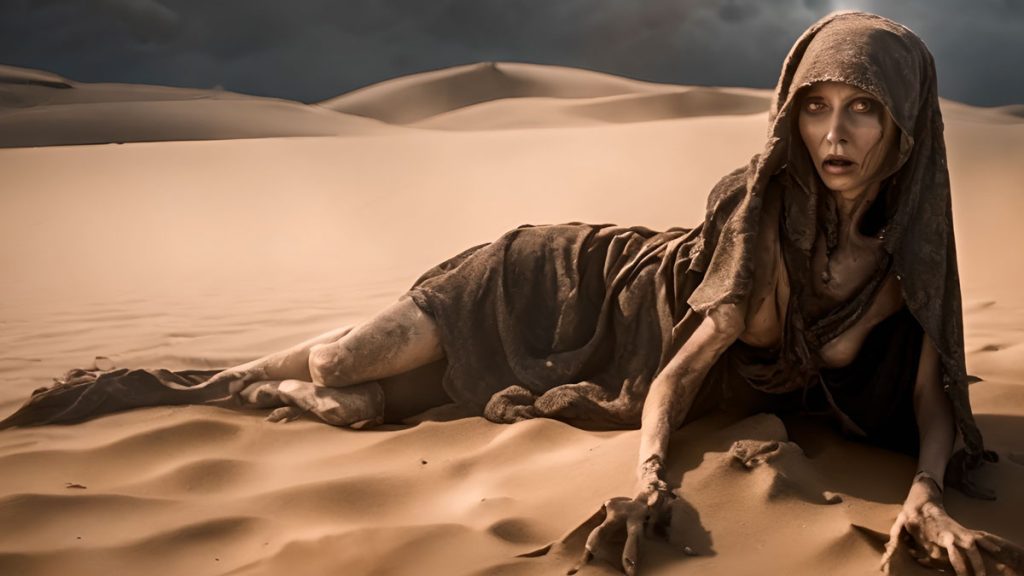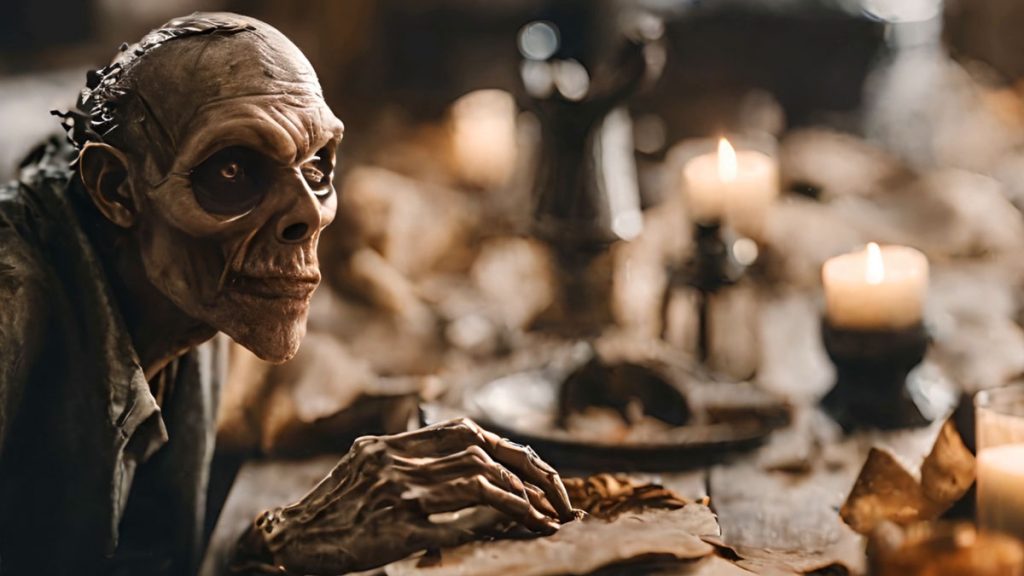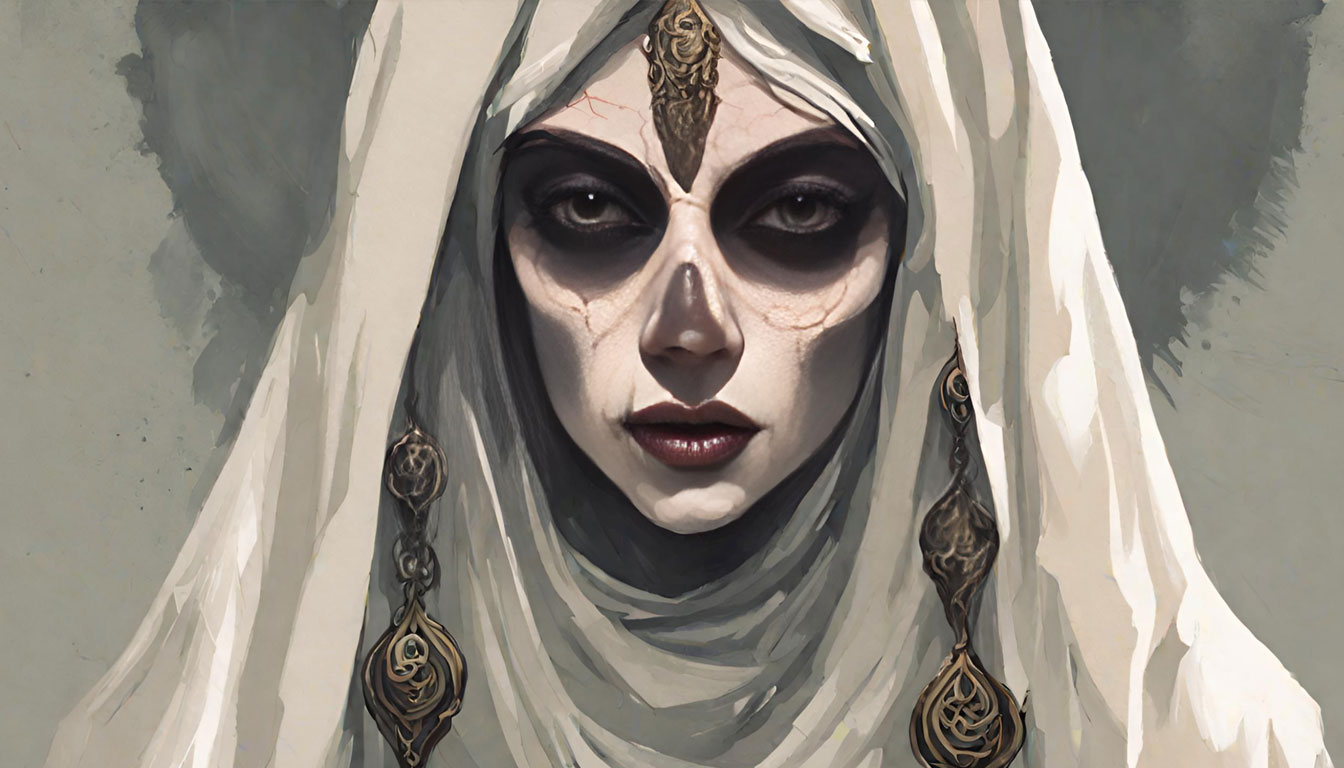Ghouls are monsters or spirits which originated from Arabic mythology. More modern interpretations see them as shapeshifting cannibal-like creatures that can change into human form.
The folklore of ancient Arabia presents the ghoul (ghūl) as a solitary being dwelling in uninhabited places such as the deep desert or burial grounds. They are said to be related to the Jinn, spirits born of Iblis himself (Satan in Islam).
In these tales, the ghoul can appear as an attractive woman, seducing unwary travelers and then eating them. They can only be killed by a single blow, any more than that, and they will come back to life.
Ta’abbata Sharran’s ghoulish poems
One of the primary sources for information on the ghoul legend is from the pre-Islamic poet Thabit ibn Jabr, better known by his epitaph Ta’abbata Sharran, and one of the brigand poets. Writing in the late 6th or early 7th century, in several of his poems he describes meeting a ghūl in the desert.

In the first of these poems, the protagonist fights the creature and kills her before taking the body back to his camp. He describes her as having eyes set in a hideous cat-like head and having a split tongue. He says she has legs like a deformed fetus and the back of a dog. Clothed in rags or old skins.
Of how I met the ghūl swooping down
on the desert bare and flat as a sheet.I said to her, “We are both worn with exhaustion,
brothers of travel, so leave my place to me!She sprang at me, then my hand raised
against her a polished Yemeni blade.Then undismayed I struck her: she fell flat
prostrated on her two hands and on her throatlatch.She said, “Strike again!” I replied to her, “Calm
down,
mind your place! For I am indeed stout-hearted.”I lay upon her [through the night]
that in the morning I might see what had come to
me.Behold! Two eyes set in a hideous head,
like the head of a split-tongued cat,Legs like a deformed foetus, the back of a dog,
Poem by Ta’abbata Sharran
clothes of haircloth or worn-out skins!’

In another poem, he tells how, after waking, he finds the ghūl, his neighbor. He tries to couple with her but sees the ghūl’s hideous face when she struggles. But when she looks at him, he’s shown to be even more “ghul-ish” than her. He then takes out his sword and kills her, sending “the skull of the Jinns’ daughter flying.”
Then morning came and I found that the ghūl
was my neighbor;
and 0 neighbor, how hideous you were!
I tried to couple with her, but she writhed
exposing a face that was horrible, ghul-ish
Then I said to her, “Look, so you may see!”
She turned and I was more ghūl-ish than she!
Then my streaked sword that had worn out its
sword-belt sent the skull of the jinns’ daughter flying
Poem by Ta’abbata Sharran
Interestingly, the poems are written in a very similar style to romantic verses of the time, though instead of sneaking out to meet their secret love in some forbidden oasis, they encounter a ghoul.
Suzanne Pinckney Stetkevych notes in her 1984 paper that this poem gives the creature a role more akin to Lilith or even the Sphinx. In Greek myth, the latter similarly devours her unfortunate victims.
The ghoul is often seen as a representation of the desert itself. Stalking or even seducing unwary or tired travels to their death. Like the desert sands, its appearance and nature are constantly shifting.
Modern tales of ghouls
The most common contemporary stories regarding the origin of the ghoul are that they are a kind of demon, the result of cross-breeding between demons and humans, or that they are normal humans suffering from a curse.
Legend tells us that ghouls are hard to tell apart from normal humans. However, in order for a ghoul to remain this way, they must eat human flesh regularly. If they do not, their physical appearance will begin to change. Their skin becomes pale, with veins being clearly visible, and their nails will be long and claw-like.
In extreme cases, the ghoul will suffer the physical consequences of starvation (even if they eat other types of food), and their mental state will begin to deteriorate.
If this state of affairs continues, the ghoul will eventually lose all semblance of humanity.
A ghoul must eat between 10 and 15 pounds of human flesh each day in order to remain healthy. It is thought that most ghoul children are fed human flesh, but the effects of being deprived of human flesh do not manifest themselves until a child reaches puberty.
Ghouls are thought to mate with each other in the same way as humans, although it is believed that they may sometimes breed with humans to prevent inbreeding.

One legend states that a human and a ghoul can only produce a child if the human has first been buried alive or kept in a crypt for 24 hours prior to the consummation of the union.
Human women are allegedly kept hostage until the child is born. After the birth, the woman is eaten. Human men who mate with ghoul women live on, but their lifespan is supposedly reduced.
Generally, ghouls are considered physically stronger than humans, but not significantly stronger. Some stories tell of the ghoul being able to turn into an animal, such as a jackal or hyena.
Disturbingly, ghouls are said to be able to take on the form of anyone whose flesh they have eaten. It is believed that some human cannibals are, in fact, ghouls.
H.P. Lovecraft’s stories
American horror writer H.P. Lovecraft mentioned ghouls in several of his short stories. In Pickman’s Model a rogue artist’s paintings are so disturbing that he is thrown out of the local art society. Later, we find out the inspiration for these hideous subjects is not his imagination but real ghouls he has been using as models.
In another, perhaps more sympathetic story, The Outsider, a lonely narrator despairs at being isolated in a desolate castle. Craving contact with other humans, he finds his way to the top of a staircase. This leads him into a graveyard, and when he tries to approach people in nearby houses, they flee in terror. Stumbling across a mirror, he realizes his ghoulish appearance is the reason for the terror…he’s not human.
Sightings
A young lady and her boyfriend believe they encountered a ghoul in 2014 while on a camping trip. They were walking along a dirt road when the young lady stopped in her tracks; a chill ran down her spine.
They both had a bad feeling about continuing, so they turned back to take another route. They began to run, but then her boyfriend stopped and stared into a nearby field.
They both saw a very tall, very slender, shadow-like figure just standing about 100 feet away in the field. This figure leaned forward and then moved to the left – the couple say it was as if it teleported.
Frightened, they turned and ran back to their campsite – the figure didn’t follow them.
An alleged ghoul encounter came from rural West Virginia in 2003. Two survivors described coming across, and ultimately killing, a family they say were ghouls.
Stories of captured ghouls abound in recent history, including the ghoul captured by Mike Mulligan in the late 1960s. Mulligan interviewed the ghoul, and it is thought that this interview forms the basis of much of what we know about ghouls.
An early account of an alleged ghoul was related in Paris in 1849. Sergeant Francoise Bertrand was sentenced to death for digging up corpses and eating their flesh. Some thought he was a vampire, but his behavior was very closely related to that of a ghoul.
| Other Name/s | Ghouleh (female ghoul), ghūl |
| Location | MIddle-east, Worldwide |
| Type | Monster, Spirit |
| Habitat | Desert, Graveyards, Cities, Forest |
References
cryptidz.wikia.com, “Ghilan”, accessed August 16 2017.
tattoonicorn.tumblr.com, “Ghoul”, accessed August 17 2017.
ghostsnghouls.com, “Reader Submission: Real Slender Man Sighting?”, accessed August 18 2017.
theshadowlands.net, “Ghouls”, accessed August 18 2017.
Stetkevych, Suzanne Pinckney. “The Ṣuʿlūk and His Poem: A Paradigm of Passage Manqué.” Journal of the American Oriental Society, vol. 104, no. 4, 1984, pp. 661–78. JSTOR, https://doi.org/10.2307/601898. Accessed 30 Jan. 2024.
